Related Research Articles

The Dorking is a British breed of domestic chicken. It is named for the town of Dorking, in Surrey in southern England.

The Indian Game is a British breed of game chicken, now reared either for meat or show. It originated in the early nineteenth century in the counties of Cornwall and Devon in south-west England. It is a heavy, muscular bird with an unusually broad breast; the eggs are brown.

The Sussex is a British breed of dual-purpose chicken, reared both for its meat and for its eggs. Eight colours are recognised for both standard-sized and bantam fowl. A breed association, the Sussex Breed Club, was organised in 1903.

The Scots Dumpy is a traditional Scottish breed of chicken. It is characterised by very short legs, so short that the body is a few centimetres from the ground; as in other breeds of creeper chicken, this chondrodystrophy is caused by a recessive lethal allele. The Dumpy has at times been known by other names, among them Bakie, Corlaigh, Crawler, Creeper and Stumpy. There are both standard-sized and bantam Scots Dumpies. It is one of two Scottish breeds of chicken, the other being the Scots Grey.
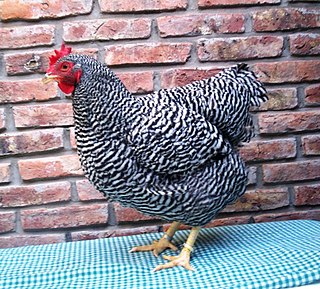
The Plymouth Rock is an American breed of domestic chicken. It was first seen in Massachusetts in the nineteenth century, and for much of the early twentieth century was the most popular chicken breed in the United States. It is a dual-purpose breed, raised both for its meat and for its brown eggs. It is resistant to cold, easy to manage, and a good sitter.
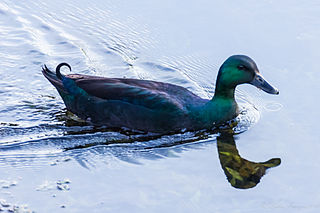
The Cayuga is an American breed of domestic duck. It was introduced to the Finger Lakes region of New York State in about 1840, and is named for the Cayuga people of that area. Until the last years of the nineteenth century it was the principal duck reared for meat in the United States. In the twenty-first century it is kept mainly for ornament.
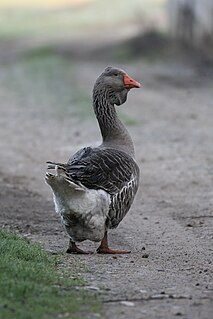
The Toulouse is a French breed of large domestic goose, originally from the area of Toulouse in south-western France. Two types are recognised: a heavy industrial type with dewlaps, the French: Oie de Toulouse à bavette; and a slightly lighter agricultural type without dewlaps, the French: Oie de Toulouse sans bavette. Both types are large, with weights of up to 9 kg. Birds bred in the United Kingdom and United States exclusively for showing may be still larger, and have a somewhat different conformation.

The Emden or Embden is a German breed of domestic goose. It is named for the town of Emden in north-westernmost Germany.

The Norfolk Grey is a utility breed of chicken that originated near the city of Norwich, in Norfolk, England, in around 1910. The breed was originally created by Frederick W Myhill of Hethel, Wymondham under the name Black Maria. It is a rare breed which is currently considered to be at risk by the Rare Breeds Survival Trust.

The Legbar is a rare British auto-sexing breed of chicken. It was created in the early twentieth century by Reginald Crundall Punnett and Michael Pease at the Genetical Institute of Cambridge University. They cross-bred American barred Plymouth Rock birds with brown Leghorns and created the gold and silver colour varieties. Pease created a cream Legbar by cross-breeding these with white Leghorns; later crossing with Araucanas caused this to have a crest and to lay blue or blue-green eggs.

The Sebright is a British breed of bantam chicken. It is a true bantam – a miniature bird with no corresponding large version – and is one of the oldest recorded British bantam breeds. It is named after Sir John Saunders Sebright, who created it as an ornamental breed by selective breeding in the early nineteenth century.

The Campine is a breed of domestic chicken originating in the northern part of Belgium. It is named for the Campine region of north-eastern Belgium and south-eastern Netherlands. It was known there as the Kempisch Hoen.
The Nankin Bantam or Nankin is a British bantam breed of chicken. It is a true bantam, a naturally small breed with no large counterpart from which it was miniaturised. It is of South-east Asian origin, and is among the oldest bantam breeds. It is a yellowish buff colour, and the name is thought to derive from the colour of nankeen cotton from China.

The Derbyshire Redcap is a breed of chicken originating in the English county of Derbyshire. The name "Redcap" derives from the breed's unusually large Rose-type comb. British breed standards dictate a length of more than 7 centimetres (3 inches) of length for a Redcap comb. It is covered in small, fleshy points, and has a distinct spike pointing backwards called a "leader". Combs, wattles and earlobes are all ideally bright red.

The Old English Pheasant Fowl is a British breed of small utility chicken. It derives from traditional breeds of rural Lancashire and Yorkshire and of the former counties of Cumberland and Westmorland. Its name is due to a perceived similarity of the plumage to that of the wild pheasant. It is a rare breed, and in 2014 was listed as "at risk" by the Rare Breeds Survival Trust.

The Scots Grey is a dual-purpose breed of domestic chicken originating in Scotland, where it has been bred for more than two hundred years. It was formerly known as the Scotch Grey and until about 1930 was popular in Scotland. It is on the "Native Poultry Breeds at Risk" list of the Rare Breeds Survival Trust.

The Silver Appleyard is a British breed of domestic duck. It was bred in the first half of the twentieth century by Reginald Appleyard, with the aim of creating a dual-purpose breed that would provide both a good quantity of meat and plenty of eggs.
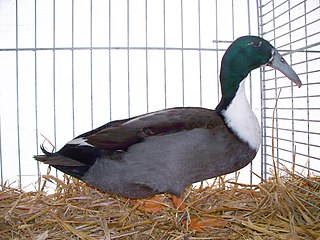
The Hook Bill or Dutch Hookbill is a breed of domestic duck characterised by an unusual down-curved beak. It is an ancient breed, and has been documented since the seventeenth century. Speculation that it originated in Asia, or is related to the Indian Runner, is apparently unsubstantiated.
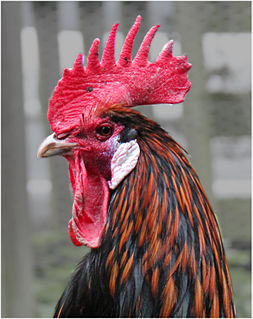
The Bergische Kräher is a German breed of domestic chicken from the Bergisches Land, in the state of North Rhine-Westphalia in western Germany. It is named for its unusually long crow, up to five times as long as that of other breeds, and belongs to the group of long-crowing chicken breeds, which are found from south-east Europe to the Far East.

The Augsburger is an endangered German breed of domestic chicken. It originates from the area of the city of Augsburg, in the Swabian region of the state of Bavaria, in southern Germany. It was bred in the nineteenth century, and derives mostly from the French La Flèche breed. It is the only chicken breed of Bavarian origin.
References
- 1 2 Native Poultry Breeds at Risk. Rare Breeds Survival Trust. Archived 1 July 2014.
- 1 2 3 Chris Graham (2006). Choosing and Keeping Chickens. London: Hamlyn. ISBN 9780600614388.
- 1 2 3 4 5 6 7 8 Victoria Roberts (2008). British poultry standards: complete specifications and judging points of all standardized breeds and varieties of poultry as compiled by the specialist breed clubs and recognised by the Poultry Club of Great Britain. Oxford: Blackwell. ISBN 9781405156424.
- ↑ Breed Classification. Poultry Club of Great Britain. Archived 12 June 2018.
- 1 2 Chickens. Poultry Club of Great Britain. Archived 9 November 2018.
- ↑ Barbara Rischkowsky, D. Pilling (eds.) (2007). List of breeds documented in the Global Databank for Animal Genetic Resources, annex to The State of the World's Animal Genetic Resources for Food and Agriculture. Rome: Food and Agriculture Organization of the United Nations. ISBN 9789251057629. Accessed October 2014.
- 1 2 3 Poultry: Ixworth: 2008 Watchlist; Category 2, Endangered. Rare Breeds Survival Trust. Archived 24 June 2008.
- ↑ P.M. Hocking, M. Bain, C.E. Channing, R. Fleming, S. Wilson (2003). Genetic variation for egg production, egg quality and bone strength in selected and traditional breeds of laying fowl. British Poultry Science44 (3): 365–373. doi:10.1080/0007166031000085535. (subscription required).